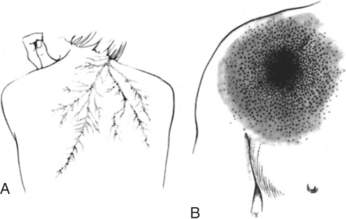LIGHTNING STRIKE
Lightning strikes the earth at least 100 times per second during an estimated 3,000 thunderstorms per day. Fortunately, the odds of being struck by lightning are not very great. Still, approximately 60 persons per year are victims of fatal strikes in the United States. The wise traveler respects thunderstorms and seeks shelter at all times during a lightning storm.
Lightning can injure a person in five ways:
1. Direct hit, which most often occurs in the open.
2. Splash, which occurs when lightning hits another object (tree, building). The current seeks the path of least resistance, and may jump to a human. Splashes may occur from person to person, or from a metal fence.
3. Contact, when a person is holding on to a conductive material that is hit or splashed by lightning.
4. Step (stride) voltage (or ground current), when lightning hits the ground or an object nearby. The current spreads like waves in a pond.
5. Blunt injury, which occurs from the victim’s own muscle contractions and/or from the explosive force of the shock wave produced by the lightning strike. These can combine to cause the victim to be thrown, sometimes a considerable distance.
When lightning strikes a person directly, splashes at him from a tree or building, or is conducted along the ground, it usually largely flows around the outside of the body (flashover phenomenon), which causes a unique constellation of signs and symptoms. The victim is frequently thrown, clothes may be burned or torn (“exploded” off by the instantaneous conversion of sweat to steam), metallic objects (such as belt buckles) may be heated, and shoes removed. The victim often undergoes severe muscle contractions—sufficient to dislocate limbs. In most cases, the person struck is confused and rendered temporarily blind and/or deaf. In some cases, there are linear (1½ to 2 in, or 1.3 to 5 cm, wide, following areas of heavy sweat concentration), “feathered” (fernlike; keraunographism; Lichtenberg’s flowers—cutaneous imprints from electron showers that track over the skin) (Figure 215, A), or “sunburst” patterns of punctate burns over the skin (Figure 215, B), loss of consciousness, ruptured eardrums, and inability to breathe. Occasionally, the victim ceases breathing and suffers a cardiac arrest. Seizures or direct brain damage may occur. Eye injuries occur in half of victims.
A victim struck by lightning may not remember the flash or thunder, or even recognize that he has been hit. The confusion, muscle aches, body tingling, and amnesia can last for days. With a more severe case, the skin may be mottled, the legs and/or arms may be paralyzed, and it may be difficult to locate a pulse in the radial (wrist) artery (see page 33), because the muscles in the wall of the artery are in spasm. First-, second-, or third-degree skin burns may be present. Broken bones are not uncommon.
1. Maintain the airway and assist breathing (see page 29). Continue to perform artificial respiration and cardiopulmonary resuscitation (CPR) (see page 32) until sophisticated help can be obtained. Victims of lightning strike may have paralysis of the breathing mechanism for a period of 15 to 30 minutes, and then make a remarkable recovery. A seemingly lifeless individual may be saved if you breathe for him promptly after the injury. Do not assume that dilated or nonreactive (to light—see page 36) pupils are a sign of death, because they may represent direct injury to the eye(s).
2. Assume that the victim has been thrown a considerable distance. Protect the cervical spine (see page 37).
3. Examine the victim for any other injuries and treat accordingly.
4. Transport the victim to a hospital.
5. If you are in the vicinity of a thunderstorm, seek shelter for the victim and yourself. Lightning can strike twice in the same place!
Stay updated, free articles. Join our Telegram channel

Full access? Get Clinical Tree





